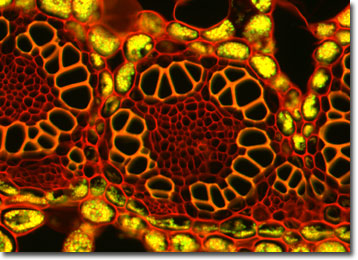Fluorescence Digital Image Gallery
Sweet Flag Grass
Sweet flag, taxonomically classified as Acorus calamus, is a grass-like perennial that can grow up to 2 meters or 6.6 feet high. Along with the common cattail, sweet flag thrives in wet areas like the edges of streams, ponds, and lakes. The thick, erect leaves of the plant resemble those of an iris and, though it rarely flowers, its blossoms are greenish brown cylinders covered in little, rounded spikes.

The roots of sweet flag spread horizontally very close to the surface of the soil and are a known favorite snack of the muskrat. Sweet flag spreads by means of rhizomes, a subterranean stem, thickened with deposits of food reserves. These specialized plant stems produce shoots and root systems that will develop into new plants. Rhizomes enable plants to propagate vegetatively and to perennate, or survive an unfavorable season, hidden underground, protected from adverse elements.
The Cree Indians used sweet flag for medicinal purposes, primarily as an analgesic for toothaches or headaches, a disinfectant for teeth, relief for exhaustion or fatigue, and as a cure for hangovers. Other North American Indians used the plant to treat coughs and diabetes. The Sioux used the whole plant, making aromatic garlands from the leaves and using the roots to make tea to treat bowel pains or placing chewed root on the skin to cure illness. Sweet flag has also been used by the Chinese to reduce swelling and to help relieve constipation. In India, the root was used to cure fevers, asthma, and bronchitis. The ancient Greeks also utilized the plant in many traditional remedies. The root was even mentioned in the Bible (Exodus 30: 22-25) as one of the ingredients of the "holy anointing oil." Despite the plant's rich history, it has been banned by the FDA as a food additive because it has proven to be carcinogenic in laboratory rats.
The specimen presented here was imaged with a Nikon Eclipse E600 microscope operating with fluorite and/or apochromatic objectives and vertical illuminator equipped with a mercury arc lamp. Specimens were illuminated through Nikon dichromatic filter blocks containing interference filters and a dichroic mirror and imaged with standard epi-fluorescence techniques. Specific filters for the sweet flag grass stained thin section were a a B-2E/C and a Y-2E/C. Photomicrographs were captured with an Optronics MagnaFire digital camera system coupled to the microscope with a lens-free C-mount adapter.
BACK TO THE FLUORESCENCE DIGITAL IMAGE GALLERY
